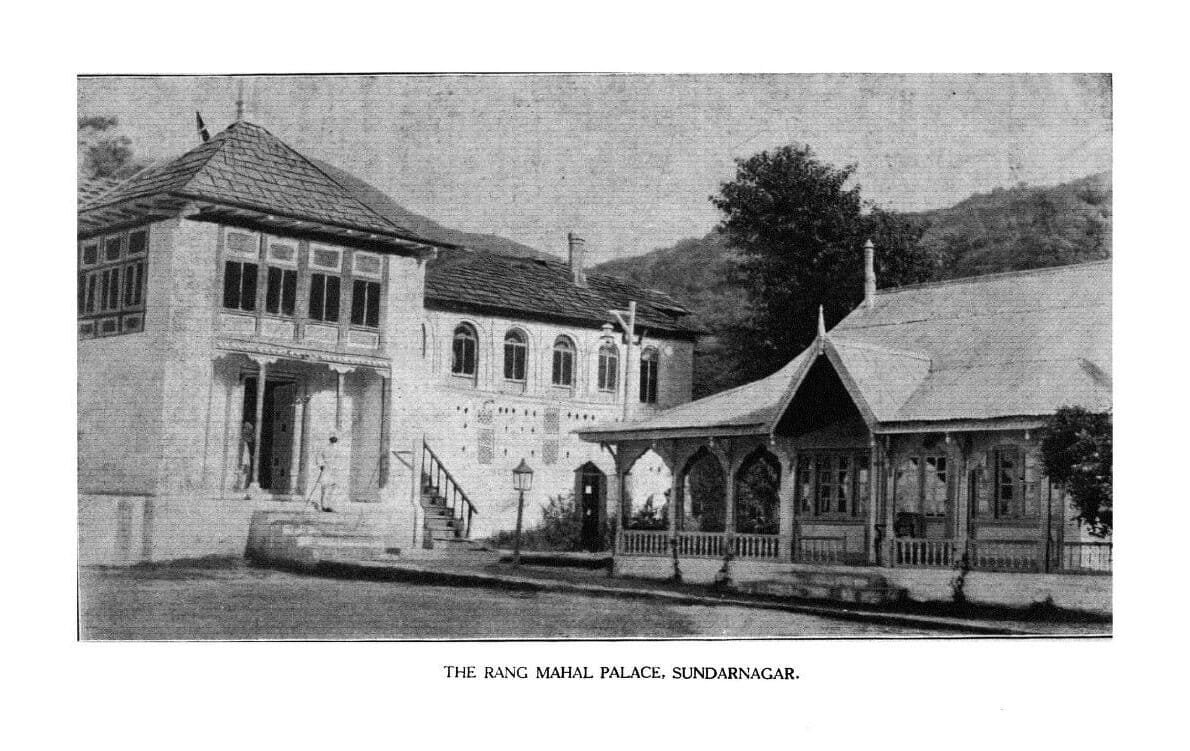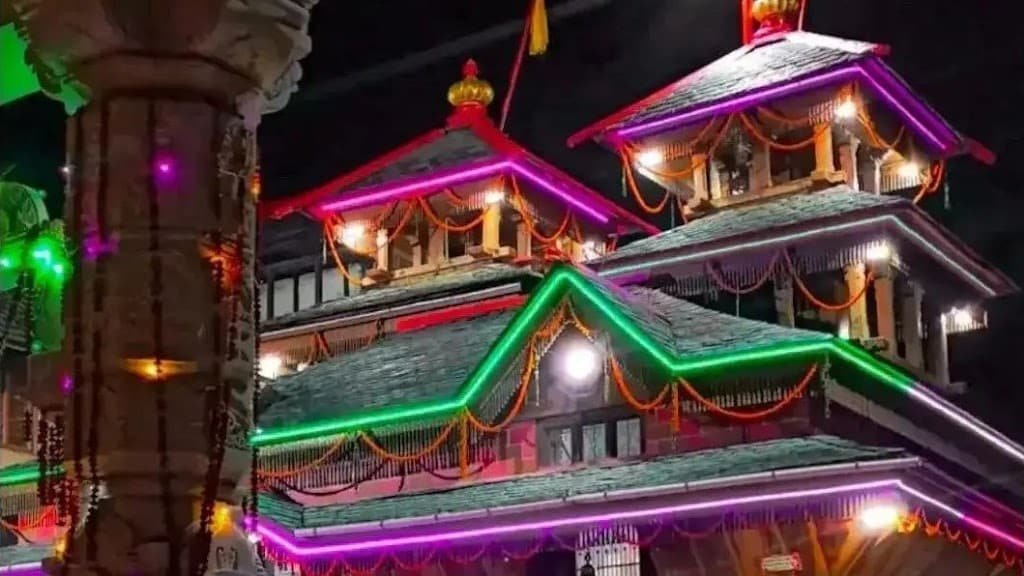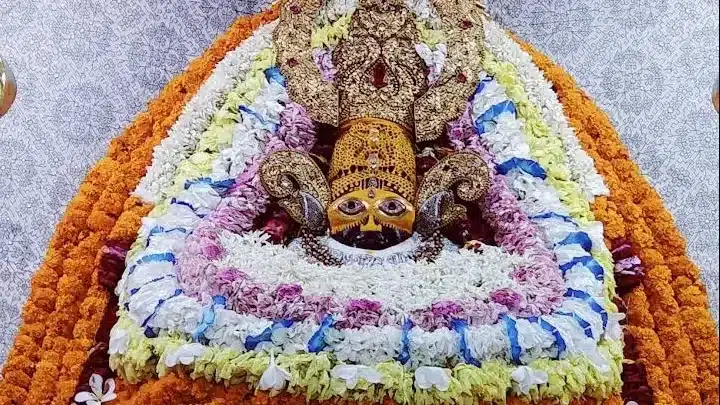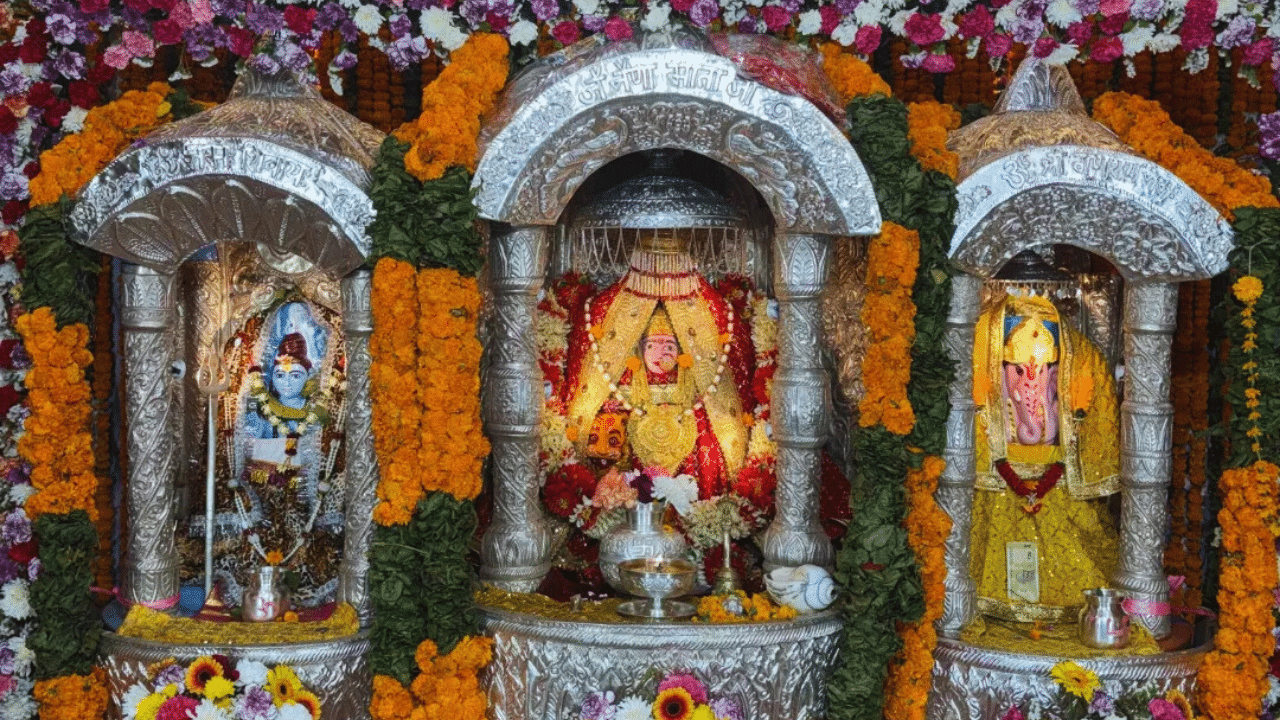Sunder Nagar is a City and a municipal council in Mandi district in the Indian state of Himachal Pradesh. Formerly it was a princely state, known as Suket.
Suket state is also a part of the modern Mandi district. The origin of the name ‘Suket’ is uncertain, but it may be a derivation of ‘Sukshetra’, which means ‘the good land’, according to J. Hutchinson. Before its foundation, the whole tract was under the title of ‘Rana’ or ‘Thakur’ and the vernacular history gives a graphic account of their subjection by the early Rajas. Sir A.
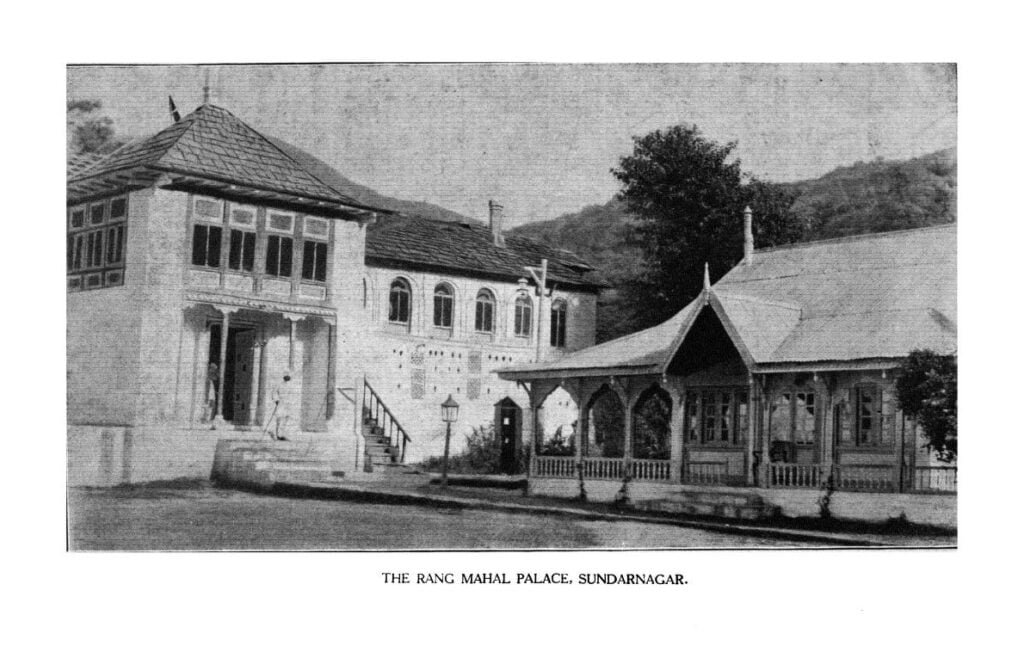
Table of Contents
Cunningham assigns the foundation of Suket to an early period (A.D.765). According to him, it is probable that there was an early Sen Dynasty in Bengal, whose ancestor named Vira Sena, reigned in the seventh century and from whom the later Sen dynasty was descended, Vira or Bir Sen founded Suket.
Bir Sen (A.D. 765): After crossing the Satluj at Jiuri Ferry, he penetrated the hills deeply. Ranas and Thakurs resented but due to mutual jealousy, could not provide a strong opposition. The first to take the field against him was the Thakur of Karoli (whose state was called Darehat) but was subdued and his fort captured. Sri Magal the Rana of Batwara who had come to help the Thakur of Karoli, was also lost in the face of the superior force of Bir Sen.
Following up his initial success, Bir Sen subdued the Thakur of Nagar (occupying territory of Kot and Pargna) hence Thakur of Chirag, (ruled betel and thana Chawaindi) “Thakur of Chandiwala (ruling Udaipur) and Thakur of Khunu”. A pitched battle took with the Rana of Sanyarto, who was ultimately captured but treated with consideration and provided a Jagair, which remained under the control of his family till the reason of Shyam Sen (A.D. 1627-58). Bir Sen erected a fort on the outskirts of the ‘ Kunnu Dhar and settled down there with his family. In his renewed campaign petty chiefs, he attacked the Thakur of Koti Dhar Dehar and sized the area of Nanj”, Solalu, Delu, and Thana Magra’. He built two forts one at Kajun and other at Magra.

Next, he subdued the Thakur of Khandikot Thakur of Surhi (who owned the Thanas of Chandmari and Johar and also illqua and Pargna) and Thakur of Haryana. Bir Sen then selected a site in the Shuri illequa where he built a place and made it the capital of the state. He also built the fort of Chawasi and made it as a base and advance into Suraj and captured the forts of srigarh, narayangarh, Raghupur, Janj, Madhupur, Banga, Chanjwala. Magru Magarh Tung Jalauri Himri, Raigarh, Fatehpur Bomthaj, Raison, Godoh and Kot Mandi from different Thakurs who provably till then had been more of less under Kullu.
The Raja of Kullu Bhup Pal tried to oppose the advance of Bir Sen, but he was defeated and taken prisoner. After the conquest of Kullu, Bir Sen captured Pandoh, Nachin and forts of Chiryahon, Raiyahan, Jurahandi, Satgarh, Nandgarh, Chachiyot and Swapuri. In the westward, he moved up to as far as the Sikander Ki Dhar (now in Mandi) and defeated the Rana of Hatli. To commemorate the event, he founded a fort named Bir Kort. Thereafter, Bir Sen fixed the boundary with Kangra by erecting a fort at Seerkhad, called BIRA. He was succeeded by his son (Dhir Sen) whose reign was short.
Bikram Sen
Raja of the religious dispossession soon after his accession, installed his brother “Tribikram Sen” as the regent of the State and moved to Haridawar on pilgrimage, Kullu, a tributary of Suket still was under the rule of Hast Pal grandson of Bhup Pal. Tribikram Sen proved unfaithfully and aimed at supplanting his brother with the help of Kullu Chief . On learing this vikram Sen went to his Kinsman, the raja of Keonthal, who provided him with army.

The opposing focusing met at Juri in which both Tribikram Sen and Hast Pal fell in the battle. Bikram Sen resumed his position as raja and in a revengeful attitude invaded Kullu and subdued it. On Birkam Sens the demise his son Dhartari Sen succeeded, but there is no record of events of his period.
He had two sons and both died during his own life time. Of these, the younger was named Kharsk Sen (Mugal Sen and Pangla Sen) in some other document). He had a son Laxman Sen, a minor of two year of age, was made Raja on Dhartari Sen’s death.
Lakshman Sen
The Raja of kullu took advantage of the minority of the Lakshman Sen and asserted independence. When Lakshman Sen came of age 40 years later invaded Kullu and overran the Waziris of ruppi, Lag-Sari and a part of Parol and so kullu again became a tributary of the Suket.
Lakshman was succeeded by his son Chander Sen, who died child less. His brother Bijai Sen, Then come to the throne. Nothing of the great relevance took place during his period.
Sahu Sen(A.D.-1000)
Bijai Sen left to sons, named Sahu Sen and Bahu Sen, of whom the elder succeeded to the throne. Both brothers were not in the good terms, and so Bahu Sen retired to Manglor then in kullu, where he established himself as a petty chief his descendants in the twelfth generation founded Mandi State.
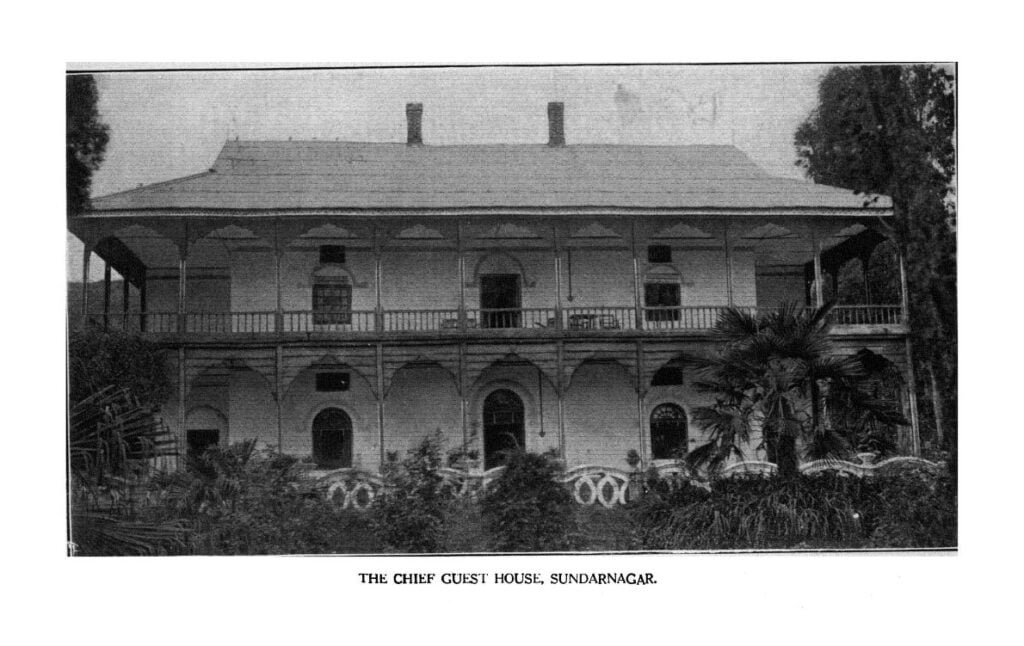
Rattan Sen (A.D.1020)
Very little is known about his period. On his demise, Rattan Sen was succeeds by his elder sons Bilas sen, a man of tyrannical attitude. He was poisoned after four years of his oppressive rule and his brother Samudra Sen was installed Raja by officials. Bilas Sen left an infant son, named sewanth Sen.
The Rani of Bilas Sen sensing danger to the life of Sewant Sen fled to Suraj found refuge with a Zamidar Samidhra Sen ruled for four years living at his demise to minor sons named Hawant Sen and Balwant Sen. Both of them in succession were placed on the throne, but died before attaining their majority without any heirs. A search was, therefore, instituted to find out Bila Sen’s infant son, to restore to him his legitimate rights.
Semant Sen (A.D.1120)
In gratitude for the kindness shown to him and his mother by the Zamidar, Sewant Sen confirmed on him with (Zakir) in the name village and built a fort there, naming it Rani ka Kot. Sewant Sen died after a long and prosperous reign.
He was followed by the foru Raja named Biladar Sen, Uagar Sen and Bir Sen. The next raja Mantar died without issue. Main madan who was widely respected for his courage and promptness was then acclaimed Raja.

Madan Sen (A.D.1240)
Madan Sen a long and prosperous reign. His first expedition was against the Rana of Nachan. He will abs fort at a short distance to the north of Pagana, the capital and called it MADANKOT he undertook an expedition across the Beas and overcome the Rana of Drang and captured the salt mines at that place. The Rana of Gumma opposed the advancing Madan Sen, but lost very badly.
He reconquered the Kullu territory. On his return journey he built the fort of Madan Pur. The Kullu records states that Madan Sen Granted the territory from Manli to Bajura to a local petty chief one Rana Bhosal. Bhaiji Sangri and Kumarsain, small states to the South of the Satluj were also reducing to submission. Shri Mangal, Rana of Batwara made as alliance with Kahloor and reveled against Madan Sen.
On his defeat, Madan Sen expelled him from the state. Sri Mangal then founded the small principality of Mangal, Madan Sen dealt severely with rebellious Rana of Hatli and Thakurs of Mahal Morain. He built the fort of the Katwalwah (on the border of Kutlehar) , restored the forts of Seoni and Tenoi, now in Bilaspur and erected the fort of Dehar in consequence of an omen.
He built the temple of Asthambnath in Pagna and transferred to Lohara on the Balh plain from Pagna. Under Madan Sen ‘s rule Suket reached the Zenith of its prosperity. Madan Sen was succeeded by Darir Sen Dhartari Sen, Prabhat Sen, Kam Sen and three more weak rulers and eights was Sangram Sen who was 28th in succession from Bir Sen.
During the period of these weak rulers, Mandi Rajas found an opportunity to push their conquests. The period from 1240 to 1480 A.D. nearby 20 years was of not much consequence in the history of Suket state.
Mahan Sen (A.D. 1480)
Sangram Sen was followed by Mahan Sen. Mahan Sen bears an evil reputation in the record, which ultimately led to his death. As Mahan Sen had no son, he was succeeded by his uncle Haibat Sen. This kind-hearted ruler was followed by Amar Sen and Ajikardan Sen.

Parbat Sen (A.D. 1500)
According to the records, he was pronounced a curse by a Purohit, who had committed suicide after being disgraced for having intimacy with a bandi or slave girl. He sought to expiate his son by conferring the Wax iris of Lag and Sari on the Brahmin’s family in Jagir but to no purpose and died soon afterwards.
From the Purohit’s family was deseeded the line of Logwati Rajas and they, then extended their way over the main Beas Valley until finally overthrown by Jagat Singh, Raja of Kullu about A.D.1650.
Kartar Sen (A.D.1520)
During his rule, the capital was shifted from Lohara to Kartarpur a newly founded town, after his own name, now called Purana Nagar. His queen was a Jaswan princess, famous for her generosity.
Arjun Sen (A.D.-1540)
He was a contemporary of Bahadur Singh son of Sidh Singh of Kullu. He was arrogant and overbearing in nature. Many of the Ranas and Thakur’s revolted against him. During his reign, half the territory was alienated from the state and regained.
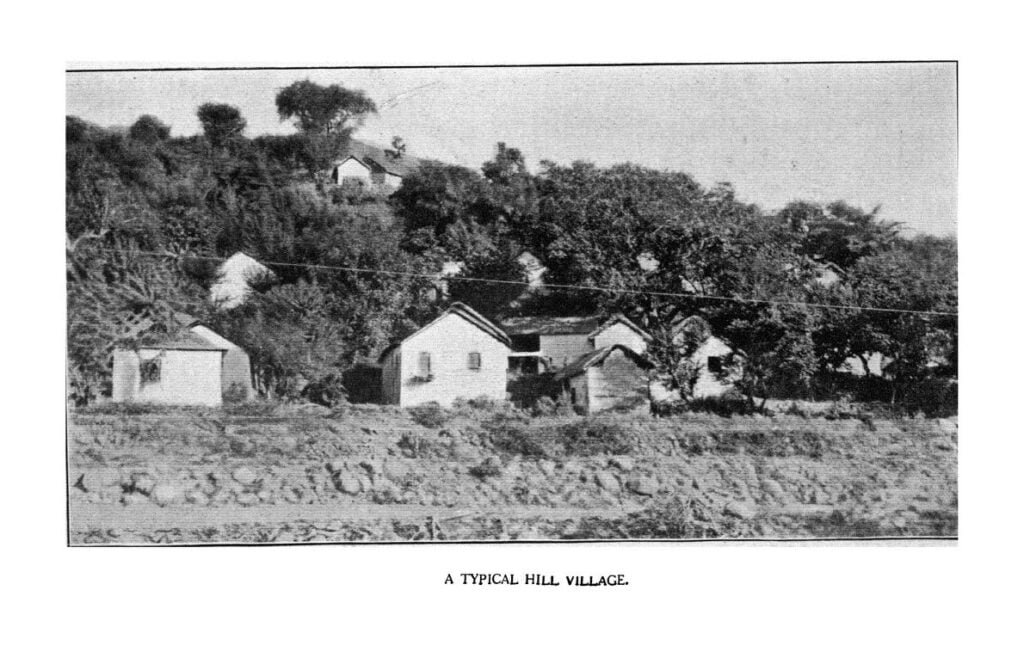
Udai Sen (A.D.1560):-
Udai Sen tried to restore the lost glory of Suket during his father’s period, but with partial success, He subdued the rebellious petty chiefs, more especially the Rana of Cheddi whose estate he confiscated and built a fort named Udai Pur to commemorate his victory.
Deep Sen (A.D. 1590)
Ruled for a long period without much detail. He was followed by Shyam Sen.
Shyam Sen(A.D. 1620)
The Raja had two Rains, one from Guler and the other from Bushahr who became enceinte about the same time. The Guleri Rani’s son Ram Sen was born first and was recognized as Tikka apparent.
The same Rani gave birth to a second son named Prithi Singh and a daughter in the due course, Bushahri Rani also had a son, named Hari Singh. Bushahri Rani, to see that her son is installed as next heir apparent, made a plot to Kill Ram Sen through Main Jughanun, One day Main Jughaun finding favorable opportunity pushed Ram Sen into cellar. Diligent search was made and at last it occurred to Naurang Singh , the Raja’s younger brother.
On this, plot being discovered, the Bushahri Rani was banished from the state, and the whole family of Main Jughaun except a pregnant woman were executed. Jughanun Mains are descended from this woman. Later on Hari Singh was also displaced form the position heir presumptive, in favour of Prithi Singh.
Aurangzeb, the Mughal emperor, summoned Shyam Sen and Naurang Singh to Lahore and ordered them to capture a strong fortress. In the successful completion of this venture, Emperor conferred on the Raja Shyam Sen a Khillat or dress of honor , with permission to issue his coins.
The chief event of Shyam Sen’s period was the war with kahlur. Raja Shyam Sen’s daughter was married to the Raja of Kahloor, Kalian Chand. The two armies met near Mahadeo and after a fierce battle, Kahlur and Mandi ( Suraj Sen of Mandi was helping Kailian Chand) were defeated. Suraj Sen fled and Kalian Chand was mortally wounded by Pathan’s in the service of Suket and captured.
To fulfill the bow of Karam Chand Kalina Chand to water his horse at tank in Suket, Raja Shyam Sen ordered that the wounded Raja should be taken to Suket in a palaki. But Kalian died on the way. The place where he died to still call Kalin Chand ki dwari. (Raja Kalian Chand had taken the bow to defeated Shyam Sen against the challenge thrown by his Rani, who was from Suket).
Raja Jagat Singh was contemporary of Shyam Sen. He had conceived the design of the making himself para amount in the hills. After subduing Chamba and Dasholi, he turned towards Mandi, Suket and Guler. Mandi Raja, Suraj Sen escaped the plot, but suket’s Shyam Sen and Man Singh of Guler were not show lucky.
Raja Shyam Sen and his brother Naurang Singh were imprisoned at Delhi on the compliant of Raja Jagat Singh of Nurpur, when they failed to furnish a contingent in an expedition to Jammu hills. Man Singh of Guler had also been imprisoned on similar grounds. During his captivity, Shyam Sen is said to have prayed to Mahun Nag who appeared to him in the form of a bee, and was promised an early release.
In 1641A.D. Raja Jagat Singh revolted against the Mughal authority, which paved the way for the early release of the Shyam Sen, Naurang Singh and Man Singh of the Guler. On their way back from Delhi, the Rana of the Bushahar attacked Shyam Sen, who had banished the former’s sister.
In this battle, Shyam Sen emerged victorious. On his return from Delhi Shyam Sen, in gratitude from his deliverance, granted a Zagir of Rs. 400/- a year to the temple to Mahun Nag (Bee) owing to the Nag having appeared to the Raja in that town. Later on, grant was reduced to Rs. 300/- a year Nar Singh, the Raja’s brother, is said to have died in prison.
During Shyam Sen imprisonment, Rja Jagat Singh of Kullu and Suraj Sen of Mandi had brought a substantial part of Suket’s territory under their control.
The Kullu Raja seized the pargans of Shrigarh Pirkot, Naraingarh Jangi Jaluri Ranghopur , Bari, Dumhri, Madanpur and Bhomari while Raja of Mandi acquired Garh, now called Suraj Mandi Raigarh, Chanjwala Magrah, Tungasi, Madhupur, Bugha, Fathepur, Baj Thaj, Bagrah, Bansi, and Gudah areas, Some local Thakur’s had also joined the invaders . Shyam Sem positioned against these invasions, through the Nawab of sirhind.
But before the liberation order could be implemented, Nawab died through fortunate in his wars with Bushahr and Kaulhur, Shyam Sen’s reign marked the beginning of repaid decline in the fortunes of Suket.
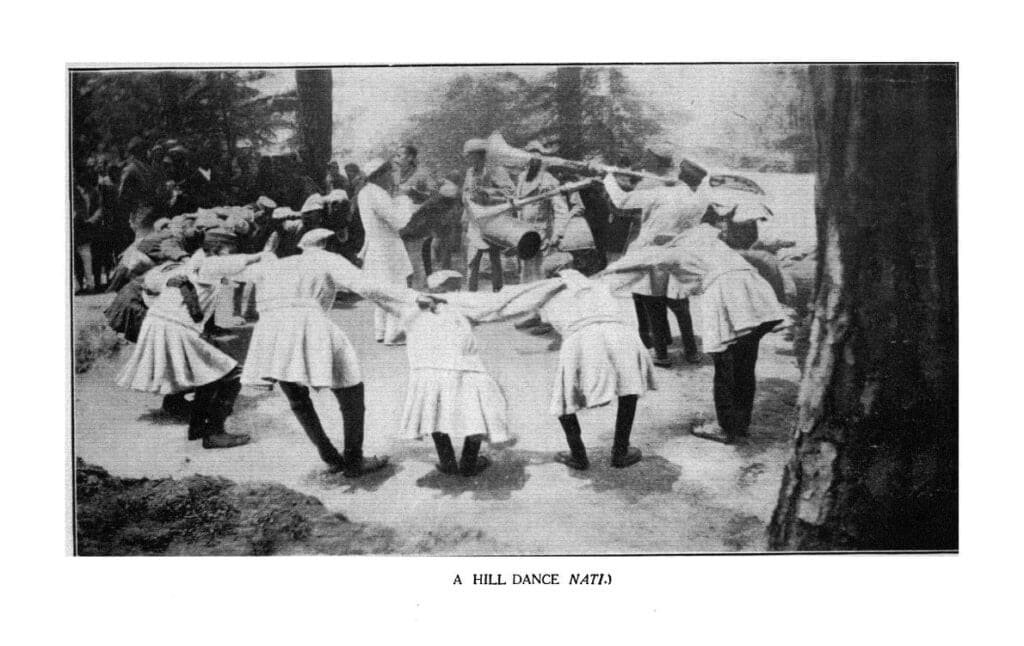
Ram Sen (A.D.1650)
Mandi and Suket had always been rivals and generally enemies. In Ram Sen’s period the struggle for the (Balh) track began and it was the scene of many conflicts. To protect the people of Mahopura, Ram Sen ereacted a fort and called it Ramgarh, after himself, Raja Ram Sen removed his sister to Pagana on the suspicion of her chastity. The suspicion was groundless and so much disgraceful that she poisoned herself. Soon afterwards, Raja became insane and died.
Jeet Sen (A.D. 1663)
Owing to his father’s insanity, Jeet Sen had been appointed regent. He seems to have been of a weak dispossession and also suffered from the epilepsy. This illness as well as other misfortunes seems to have been attributed to the influence of the dead princes in Pagana, who was worshipped as a malevolent spirit.
Jeet Sen’s 22 children died in infancy, and during his reign much territory was lost to the neighboring states, Jeet Sen also fought a battle against Shyam Sen, Raja of Mandi. The two armies met near lohara on the Balh plain and after a short conflict, Jit Sen was defeated and he fled from the field. He was chased and overpowered by a Katoch main in the service of Mandi.
The life of the Jeet Sen was spared, but the Katoch snatched the insignia of royalty from his head dress and took them to Shyam Sen. For this service, Katoch mian was given a quantity of salt from the Drang mines Mandi then annexed the Balh Plain as far as Suket Nala. Soon after words Garur Sen son of the Shyam Sen, with the help of the Raja of Kalhur conquered Garh Dhanyara Bera and Peri.
Sidh Sen, Next Raja of Mandi aided by Bhim Chand of Khalhur sized the dhar of the hatli of the end the fort of the kot from suket. The Maryauli fort was seized by Bhim Chand of Kahlur. The state Wazir, a Purohit named Anoop played treachery and assisted Raja of Mandi (Sid Sen) against the Rana of Nachan.
The Rana fought bravely for two year and at last was killed his son Harnath filed to Kahlur. Some other forts including Nachan annexed to Mandi were-Churyahan, Rayahan, Madangarh, Chaurahandi, Mastgarh, Nandgarh, Jaijios, Rajgarh and Shivpuri also called Hat.
Garur Sen (A.D.-1721)
Jit Sen died childless in 1721 A.D. The succession therefore, descended to Garuar Sen, grandson of Hari Sen, Son of Rani of the Bushehar, who had been banish from Suket in the reign of Shyam Sen. For a long time, people of Suket did not pay allegiance to him, and administration of the sate remained end of the Prithipur Main’s who had from a kind of council.
Seeing the felling against him and fearing for his owns life Garur Sen retired to Kullu and later on moved to Kangra. At both the places he was accorded high honors and reception. On his way to Kangra he married the daughter of the Rana of Himli. Becoming aware of the support given to him by Kullu and Kangra, the people of Suket also bowed to his authority and paid allegiance.
Sundernagar was (earlier known as Banned) founded by Garur Sen and a it became the capital of state in the reign of Vikram Sen. Gaur Sen’s Rani got the Suraj Kund temple constructed. By her, Garur Sen had two sons Vikram Sen and Bahadur Singh.
The Purohits of the State had fallen into disfavor after the false accusation against the daughter of Raja Shyam Sen who had poisoned herself to death and appeared in the dreams of her father Shyam Sen, brother Ram Sen and now Raja Garur Sen and warned them against Purohtis. Garur Sen died in 1748.
Bhikham Sen (A.D.1748)
This period was the beginning of grate political development in the Punjab. In 1747, Ahmed Shah Durrani invaded the province and in 1752. It was ceded to him by his name Shekh, Ahmed Shah of the Delhi. From 1765-70 many hill states declared their independence. Of a short break in 1758, all the eastern hill states and even Mugal Governs of Kangra were subject to Adina Khan. He built Adinanger near Pathankot and died in 1758.
Main while, the Sikh had been emerging a strong force and Jassa Singh Ramgarhia was the 1st to invade Kangra Hills and probably Suket too. However, states annals do not make any reference to the Sikh’s Raja Bhikham Sen had two Sons Ranjit Sen and Kishan Singh. Ranjit Sen succeeded in 1762 after his father’s death.
Ranjit Sen(A.D.1762)
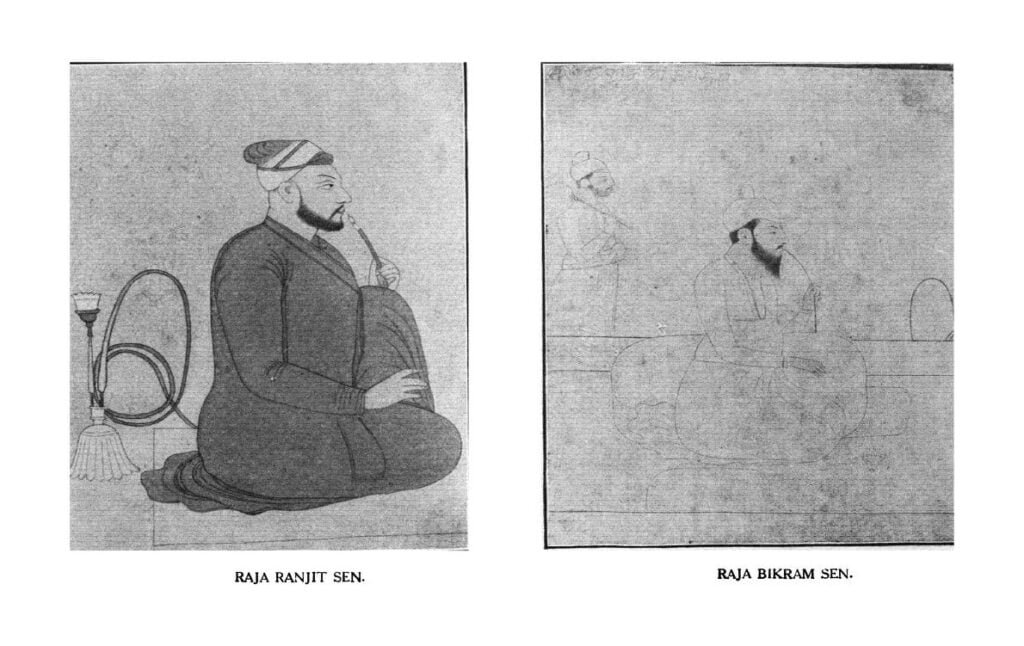
To recover Nachan from Mandi, Ranjit Se sent his younger brother Kishan Singh. After severe fighting, he captured the Shivpuri or Hat but his lead and powder ran short, and he sent messenger to Suket, who proved disloyal and unfaithful and instilled conclusion into the Raja’s mind against his younger brother. In the case of no supplies, Kisan Singh was forced to abandon the expedition.
He then wants to Sansar Chand of Kangra, who was his son in law and with his help, sacked and burnet Suket. In 1775 A.D, he retired to Jagar Nath. As earlier said, Jassa Singh Ramgarhia who made several hill states as subjects, retired from the hills in 1775, after being defeated on the plains, leaving authority in the hand of Jai Singh Kanheya, who held it till 1786.
Rajnit Sen had two Ranis , one from Sirmour and the second from Gulel. The Sirmauri Rani had a son named Vikram Sen and Guleria Ranis sons were Amar Singh and Main Singh, both died young. The administration of Ranjit Sen was in the hands of enable and faithful minister named Narpat. Bikram Sen, the heir apparent and minister Narpat were not in good terms, and on one occasion,
the younger prince in anger drew his sword and was about the strike when his father intervened. On this Bikram withdrew to Mahal-Morian (now in district Hamirpur) and resided there till his father death in 1761 A.D. form poison, accidentally administration by a physician. On the other side, Ghamand Chand and Sansar Chand tried to liberate Kangra fort from Mughals, but in vain.
Sansar Chand then asked for help from Jai Singh Kanheya, and after the death of old Naban Saif Ali Khan in 1783, the fortress fell into the hands of Sikhs with who it remained till 1786. On Jai Singh’s defeat in the plains, it was ceded to Sansae Chand and along with it he acquired the paramount power hill states between the Satluj and the Ravi rivers, including Basholi and Chamba. Suket also became a tributary,
it seems to have suffered less than other states, perhaps because of Sansar Chand’s relationship to Kishan Singh, Ranjit Sen’s a younger brother, whose daughter he had married.
Bikram Sen(A.D.1791)

His first act after his father’s funeral obsequies was to imprison Wazir Narpat in the fort of Batwara where he was soon afterwards executed. In 1972 Raja Sansar Chand invaded Mandi and made Raja Ishwari Sen, a minor, prisoner and kept him at Naduan to twelve years. Sansar Chand was helped in this venture by Kishan Singh.
Punnu Wazir was killed in a battle at Sikandar where Mandi has the help of Kahlur and Gurkhas, his brother was then appointed to the office of Wazir but was shot dead while out for hunting by Mian Bishan Singh son of Kishan Singh to whom he had acted discourteously. Bikram Sen removed the capital to Banned (now called Sundernagar), Suket or Nagar, then came to called Purana Nagar.
Meanwhile Gurkhas were emerging as a strong force. By 1805, Sansar Chand’s affogance had reached to such a point that the hill chiefs of Kangra state all joined against him and Raja of Bilaspur (Kahlur), sent and invitation to Amar Singh Thapa, the Gurkha Commander. Sansanr Chand’s forces were defeated in Mahal-Morian and the Gurkhas laid seize to Kangra fort. On reaching Naudan, they liberated Ishwari Sen of Mandi.
With the help of Raja of Bilaspur and the Gurkhas, Ishwari Sen was restored the six forts including Hatli and Balh for Bikram Sen, He was secretly carried off by some of his officials from the capticity of Gurkhas. In 1808, the forts of Hatli and Birkot had been seized by Mandi. The Kangra fort remained under Gurkhas for four year from 1806 to 1809, but they were unable to capture it.
In 1809, Raja Sansar Chand in utter despair, called for help from Maharaja Tanjit Singh and Gurkhas were compelled to retire across the Satluj. The Kangra fort and the suzerainty over hill states then passed into the hands of the Sikhs to whom all the states including Suket became a tributary. Bikram Sen had two sons, named Ugar Sen and Jagat Singh, and one daughter married in Nurpur.
The erection of Pali fort was one of the events of his reign. Willan Moorcraft (1820A.D.) was probably the first European to visit Suket, on his way to Kullu. He had left a vivid account of the state’s life, culture and geographical conditions. But he does not mention anything about the Raja and the capital city. Bikram Sen died in 1838 and was succeeded by his son Ugar Sen.
Ugar Sen (A.D.1838)
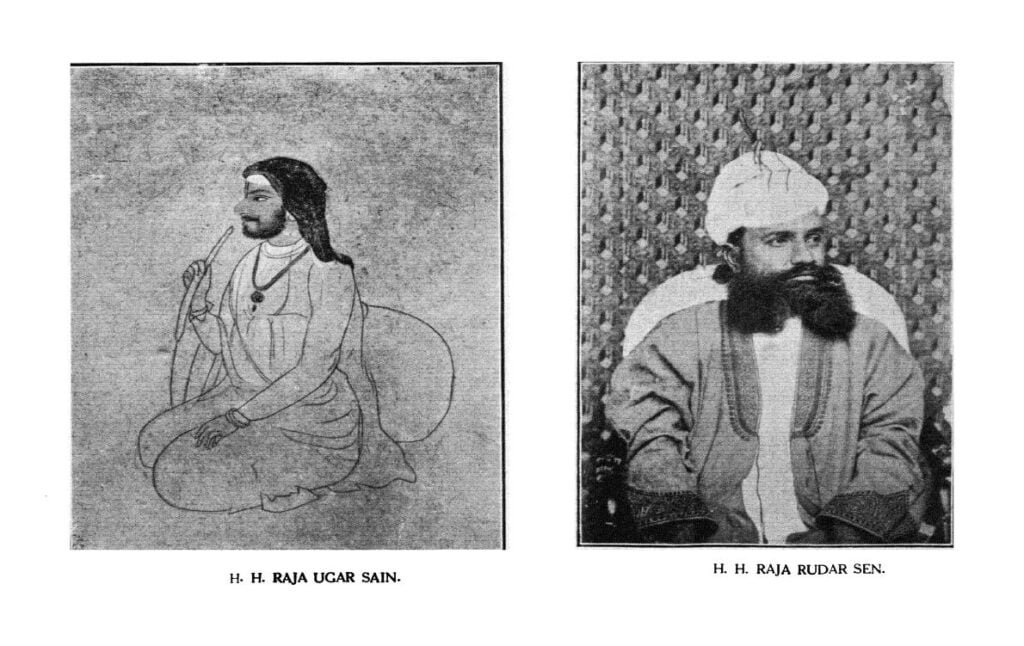
He was married four times, first in Kutlehar and by this Rani he had two sons, Sahib Singh and Ram Singh and a daughter named Dei Sharda, who in 1853 was married to Raja Sri Singh of Chamba. His Jamwali Rani bore Rudra Sen (heir-apparent) and Paiala Rani, Mian Narain Singh.
He also had three sons by concubines. In the early part of his reign, a revolt took place in Kahlur, in which Ugar Sen played the role of a good neighbor to bring peace and tranquility in the Kahlur state. In spite of that, both the states, i.e. Suket and Kahlur were not in good terms.
In 1839, a traveler Mr. Vigne visited Suket on his way back from the inner mountains. He mentions very little in his travelogues about the Suket in 1840, Nau Nihal Singh, grandson for Ranjit Singh, under the command of General Ventura sent force to siege the Rajas of Suket, Mandi and Kullu, before the invasion of Central Tibet. Raja Ugar Sen gave in his submission and was treated kindly.
The Raja of Mandi was allured to Sikh camp, made a prisoner and sent to Amritsar. The Raja of Kullu fled into the mountains. Soon after this trouble was over, a disagreement arose between Ugar Sen and heir-apparent Rudar Sen, then only 14 years of age. In consequence of which, the latter retired to Mandi.
He was brought back from Mandi by Raja Ugar Sen with the good offices of Balbir Sen of that state, In the same year 1843, Rudra Sen was married to a daughter of the Katoch family and a little later Narender Singh, son of Bishan Singh, was reconciled to Rudra Sen, resulting in another estrangement between Ugar Sen and Rudra Sen.
Narendra Singh had married his daughter to Maharaja Sher Singh of Lahore and thereby secured his support for himself and Rudra Sen. Purohit Devi Dutt, Goverdhan Kayat, Main Kesu, Thakur Das Khatri and Tana Gital all supported Rudra Sen for this reason. One Sahib Dutt had great influence over the Raja and his removal was the main object. But disclosure of some papers by Padha Narotam and Dhari spoiled the whole scheme and they were all treated with great harshness. Narotam was appointed Purohit instead.
Rudra Sen, who had sought refuge after being liberated, afterwards reconciled to his father through Mr. G.C. Barnes and came back to Suket. These events took place in 1844-45. In 1845, the Sikh army invaded British territory by crossing the Satluj and Suket was called upon to furnish contingent. But Ugar Sen joined hands with Raja of Mandi, Balbir Sen immediately after the battle of Sobraon had tendered allegiance to the British Government and both the chiefs on 21st Feb. 1846 visited Mr. Erskine at Bilaspur.
Ugar Sen expelled the Sikhs from the state. On 9th March1846, a treaty was concluded between the British and the Sikhs. Under this traty, Mandi and Suket came directly under the British control and were placed incharge of commissioner of Jalandhar. In October, 1846, Sanad was granted to Suket, defining rights and obligations of the Raja.
In 1853, Rudra Sen contracted two marriages- on in Garhwal and other in Kahlur.
In 1857 family trouble again came to light, owing to an attempt to arrest Wazir Narottam, who wielded supreme influence with the Raja and Rudra Sen again left Suket. For one and a half years, e remained in Jalandhar and Lahore. In 1859, Rudra Sen returned to Mandi on the occasion of marriage of Bijai Sen of Mandi to the daughter of the Raja of Datarpur. Uagar Sen, who was disturbed with these development, approached Colonel Lake, the Commissioner of Jalandhar, that if Rudra Sen did not agree to make peace, he should be directed to remove himself to a distance, so as not to cause trouble in the state. Accordingly Rudra left his Ranis in Mandi and went to Patiala.
After some time, Kahluri Rani with son Arimardan Sen (born in 1863) joined him at Haripur in Patiala. Two years later, a daughter was born who was after wards married to the Raja of Sirmour. In 1866, a second son named Dusht Nikanden Sen was born. The Garhwali Rani hand died in Mandi. Mainwhile, Narottam Purohit continued to hold the office of Wazir and he was also Wazir of the Narsingh temple. He also built the Durga temple.
It is said that Narottam Purohit made a law that widows should be sold and proceeds credited to the state and their property to the Nirsinghji temple. Narottam appointed one Laongu as his deputy and placed all the hill tracts under him. Soon afterwards, Raja appointed Laongu’s brother Dhaungal a Wazir and Narottam was dismissed from office. Dhaungal’s administration was oppressive. There was strong discontentment against him amongst the people. Once when he was on tour to the hills, they sized him and kept him prisoner for twelve days in Garh Chawasi. Raja Ugar Sen learning about the misdeeds of Dhaungal Wazir, put him in jail for nine months with Rs. 200,000/- fine. Wazir Dhaungal has reintroduced thefines called dand from respectable people. Raja Ugar Sen was well versed in Sanskrit and was also acquainted with music and medicine. He built the temple of Shiva at Amla Bimala, In 1876, he had paralysis and died in the same year.
Rudra Sen (A.D.1876)

He was installed as Raja by Colonel Davies Commissioner of Jalandhar, after the death of Raja Ugar Sem, his father. He was an oppressive ruler Rudra Sen reappointed Dhaungal as Wazir and Ramditta Mal to examine the state accounts. After occupying the throne, he returned to Haripur and brought his family back to Suket, but not before marrying the daughter of Jai Singh of Arki. And inquiry was set up against the oppression of Rudra Sen. On the basis of the report prepared by inquiry committee, Rudra Sen was deposed in 1879 and after spending few years in Lahore and Jalandhar, he finally settled in Hoshiarpur, where he died in 1887.
Arimardan Sen (A.D1879)
He was only 15 years of age at the time of installation. Mian Sib Singh, the brother and Jagat Singh the uncle of Raja Sen was appointed regents of the state, Sardar Hardyal Singh of Kangra was appointed Tehsildar and three years later became superintendent. Arimardan Sen died at Dharamshala soon after his accession.
Dusht Nikandan Sen (A.D 1879)

Arimardan Sen was succeeded by his younger brother Dusht Nilandan Sen. Being minor, the administration remained in the hands of Superintendent Sardar Hardyal Singh till his retirement in 1884. Then Mr. Donald was appointed Wazir till 1891. In 1888 the land assessment was reduced in the entire state, In March 1891, Mr. C.J.Hallifax I.C.S. was appointed advisor to the Raja and remained till May 1893.
Raja Dusht Nikandan Sen took keen interest in the improvement of administration. A dispensary was opened at Baned, the capital shortly after his accession, in 1893 a school Bhojpur, a post office in 1900 and a telegraph office in 1906 were opened by him. The bridge over the satluj at Jiuri was completed in 1889. Dusht Nikandan Sen was married in 1881 to a niece of Raja Dhian Singh of Arki. He had two sons named Bhim Sen (born in 1885) and Duthain Lachman Singh (born in 1894). The Raja died in 1908 A.D.
Bhim Sen (A.D. 1908)
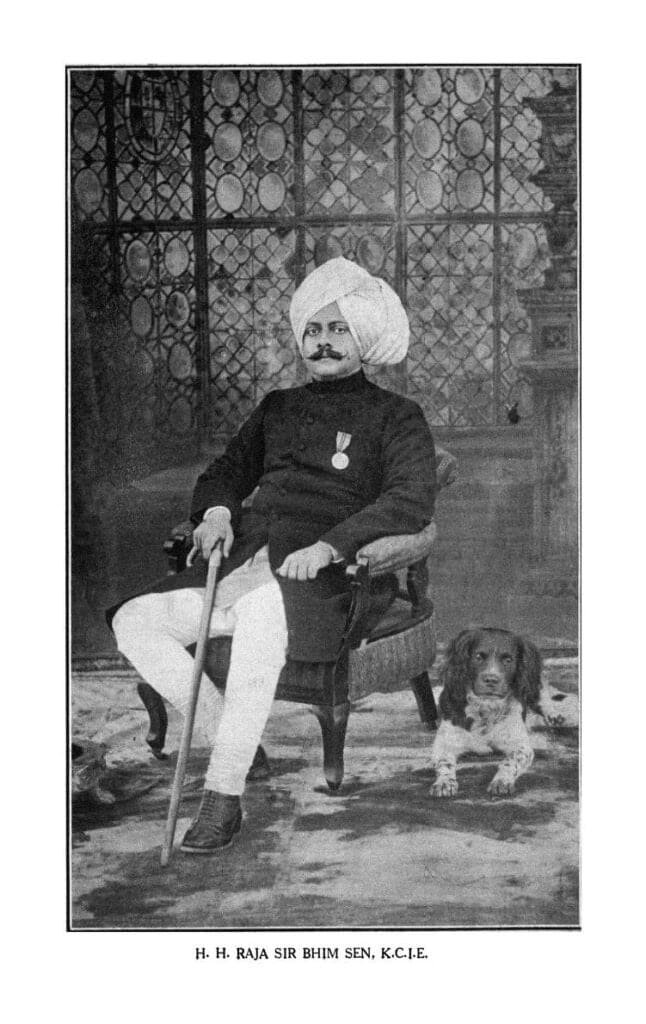
Dusht Nikandan was succeeded by his elder son Bhim Sen. He became Raja of Suket 1908 to 1919 was born on 26th November 1885. He was married 1stly to Kumari Padamawati Devi, who died in May 1959, she was daughter of Kanwar Surat Singh of Sirmaur, married 2ndly to Rajkuamri Radha Devi, daughter of Rana Raghubir Chand of Koti, she died in June, 1939, married 3rdly to Kumari Tuleshwari Devi, daughter of Main Kajan Singh of Mohanpur in koti, He died on 13th October, 1919. He was educated at the Chiefs College, Lahore and invested with full powers by Sir Louis Dane K.C.S.I. (01.01.1918) Lt. Governor of the Punjab. Bhim Sen erected a fully equipped hospital at Baned, named the King Edward Hospital, built bungalows at Baned, Seri and Dehar and a motor road from Suket to Mandi. For his services to the British during the great war, he received from the King Emperor the distinction of Knighthood. In 1919, Bhim Sen died without leaving any issue.
Lakshman Sen
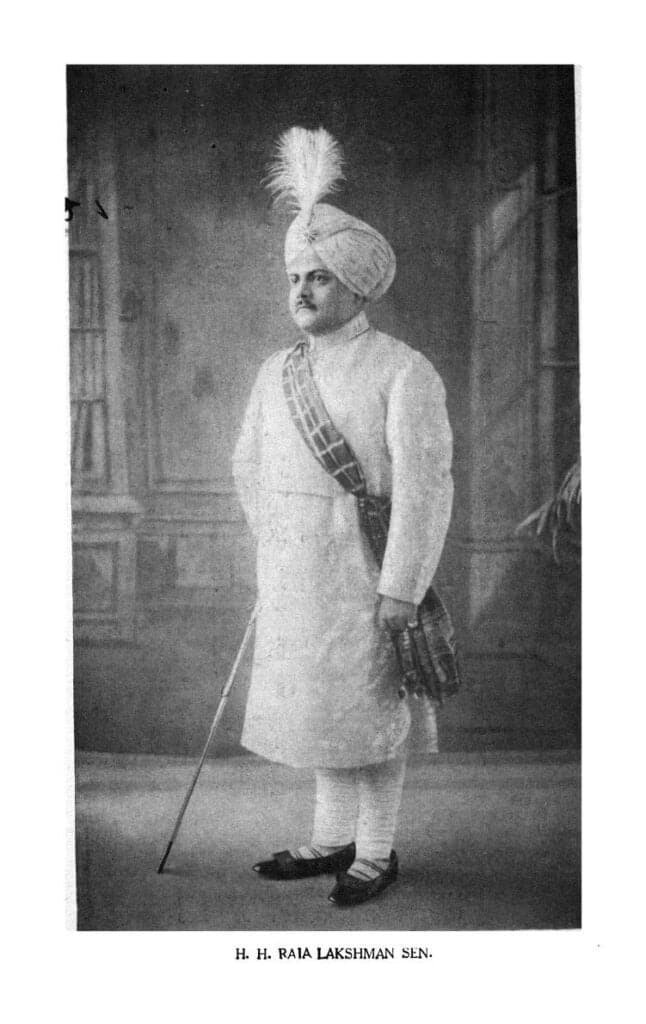
He was Raja of Suket from 1919 to 1948 Born on 14the August, 1895, succeeded his brother Bhim Sen 13th October, 1919, educated at Atchison Chiefs college, Lahore, married in 1925 to Rani Kalawati Devi, daughter of Kanwar Guman Singh of Koti, and his second wife was a Kumari of Mahlog, and had issue. He died on 30th July 1970 at Suket. He took great interest in public works and land revenue settlement. The Lakshman-Bhim Club the prince of Wales Orphan Home and Chief Court Building were constructed during his period.
Lalit Sen
Lalit Sen Bahadur was the 51th Raja of Suket 1970 to 1985. He was born on 21st April 1932 in Shimla, married on 21st February 1951, Rani Krishna Kumari, daughter of Rai-i-Rayan Maharawal Shri Sir Lakshman Singhji Bahadur of Dungarpur, and his second wife was Maharani Manhar Kanwarba Sahiba, and had issue. He died 18the October, 1985 in Delhi. He had a son named Raja Hari Sen Bahadur and daughter Rajkuari Shailaja Devi boron on 13the November, 1966.
On 1st November, 1921, Suket was transferred from the political control of Punjab Government to the Government of India till 15th August 1947.
